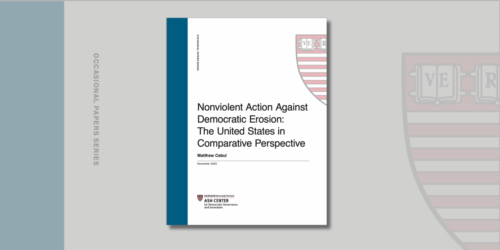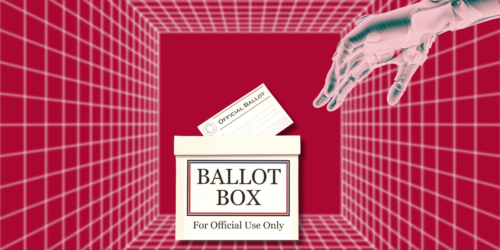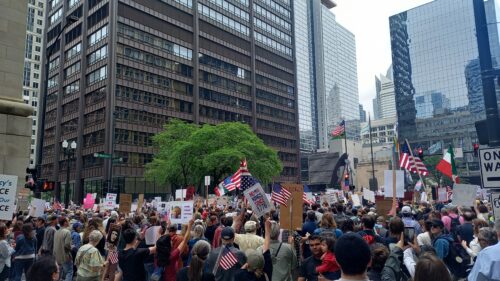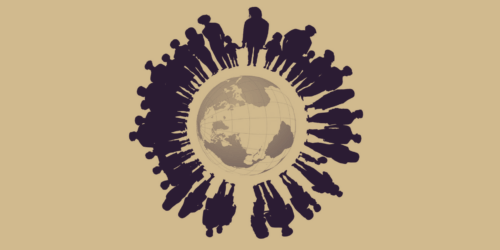The workshop on How AI Can Support Democracy Movements had a basic premise: Though AI technologies can present dangers, they also offer opportunities for pro-democracy movements. The needs from the field wholeheartedly agree with that notion. There is a huge missed opportunity if research and innovation on pro-democracy movements only focus on the dangers of AI technologies. Part of this research agenda should be understanding how pro-democracy movements are already experimenting and leveraging AI to counter hegemonic regimes.
During the 2024 presidential campaign in Venezuela and the political process building up to it, a team of Venezuelan political and social activists started experimenting with the development of AI-powered chatbots to try to even the highly asymmetrical political playing field of the electoral contest between Edmundo González Urrutia and the authoritarian incumbent, Nicolás Maduro. This team — of which I was part — was led by Roberto Patiño, an HKS graduate (MPP ’15), member of opposition party Primero Justicia, and founder of civil society organizations Mi Convive and Alimenta La Solidaridad. Martín Molina Hernández (Harvard AB ’15) and a leading conversational AI company based out of Silicon Valley, were hired to develop the bot and were crucial in providing solutions on its technical and user-experience aspects. Since the beginning of the campaign, our team had an informal association with María Corina Machado, the leader of the Venezuelan pro-democracy movement, and her campaign organization. Our contribution was the development of AI-powered chatbots that gave voters accurate voting information and the ability to report evidence of electoral fraud, deploying them via the Facebook Messenger, Instagram, and WhatsApp APIs. These were launched , first, in the days leading to the October 2023 opposition primaries and, second, during the days leading to the July 28, 2024 presidential election.
The electoral campaign proved an ideal laboratory because the tasks at hand were clear. At the same time, the target users were already hyped and eager to use any tools that would facilitate their participation and enable electoral transparency. Although these AI tools were used in the context of an election, they can also be used more broadly by pro-democracy movements. This experience showed how elections can be tech laboratories for movements to pilot tools that can be used for many purposes: nonviolent action pedagogy, gathering of community and social intelligence to better understand the state of the pillars of support of the dictatorship, gathering information on the organizational strength of the movement.
In the case of the 2023 opposition primaries, the challenge in question was that this was a self-organized election. It is worth noting that the last time the Venezuelan opposition organized presidential primaries, in 2012, it did so with the help of the National Electoral Council (CNE). But this time, the Maduro-controlled CNE could not provide the conditions requested by the main opposition coalition — the Democratic Unitary Platform. This meant that all the infrastructure of voting centers used by the National Electoral Councils was unavailable for the primary elections. Moreover, since the opposition parties are barred from using national TV channels, and digital media is often censored through the blocking of independent media websites, it was a challenge to communicate the locations of the 3,000 voting centers. This informational asymmetry represented a significant challenge in achieving a high turnout, which would provide legitimacy to the winner and momentum leading up to the presidential election.
The solution these team of activists came up with was Cheo, a Natural Language Processing (NLP) bot launched via Roberto Patiño’s Facebook & Instagram. Cheo was launched about 10 days before the primary elections and had the specific function of informing users their exact voting center and its location. This was very important because many voting centers were in people’s houses. The government cracked down on many people who offered their houses, so voting centers had to be changed even hours before they opened. The bot allowed people to have up-to-date information about where and how to participate in the primaries. The use of NLP models allowed us to accurately interpret user messages, which often used shorthand and informal Venezuelan Spanish. They also had the lowest chance of returning inaccurate information, which is highly risky in any political context. Cheo helped 26,300 voters voters find their voting centers during the primaries
Cheo was relaunched in June 2024, this time on WhatsApp, an app with strong privacy protocols that most Venezuelans use every day, to give poll workers access to required training and certificates to allow them to do their work on election day. Cheo addressed another information asymmetry that is an inherent part of any election in Venezuela: often, information for the sign-up and training of poll workers is purposely inaccessible via government websites. This time, Cheo identified and notified 2,300 polling station workers of their training status and provided instructions on how to reach the CNE via phone or in person to obtain their certification. In total, 158,000 users signed up and interacted with the bot.
Given the popularity of the first bot, Patiño’s team collaborated with María Corina Machado’s electoral team to develop the Toma El Control (TEC) bot to help citizens report illegal acts of interference on Election Day. Toma El Control was a vote-promotion platform that we created in 2023 to organize youth voter registration and participation. Through TEC’s bot, incidents were registered in 290 of the 335 municipalities and 2,004 of the 15,797 voting centers. However, this data should not be interpreted as a survey of the conditions on Election Day; this sample was not probabilistic. Over 200,000 messages were exchanged, receiving 88,885 and sending 112,080 responses with instructions to address interference at the polls. Users submitted highly detailed video and photo evidence of the Election Day incidents they reported.
From the start, the TEC bot looked up the user’s ID in the electoral registry and provided information on their voting center in the CNE’s official format. After identifying their assigned polling center, the bot allowed users to report any violations of the electoral code. The challenge was allowing users to submit incident reports from centers other than those assigned to them in case they witnessed something suspicious/foul play on the street or served as official party witnesses or polling station staff. To this end, a function was designed to search for the five closest voting centers by pulling the user’s geolocation via WhatsApp. This function worked across Venezuela, with successful tests in remote states like Delta Amacuro. Once the user chose the voting center where they wanted to report an incident, the Toma El Control bot presented a menu with a list of categories of electoral code violations. Upon selecting the complaint category, the bot followed with a detailed explanation of each complaint in the category and an abbreviation for the new menu button. Due to the limited development time, abbreviations were used to avoid ambiguity between users and the bot, aiming to receive only the specific incident they wanted to report. After the user selected the complaint, the bot provided the following steps to verify the vote count through witnesses and poll workers. Finally, this bot also asked users to share their experiences on WhatsApp so that everyone could defend their vote on July 28th. While the bot was open to all Venezuelans, opposition leader Maria Corina Machado picked it up and shared it on X. Thus, the users sympathized with her and Edmundo, and many represented them as opposition witnesses at the polls. Three thousand users were registered as polling stations were installed, and almost 7,000 additional users were registered on Election Day.
There are many lessons learned from this experience, both on the technical and the political aspects. On the technical aspect, it was crucial to pilot the bot to improve its functionality and for the NLP model to learn and “make mistakes”. On the political side, it is worth noting that this technology was tested not from the core of the Edmundo González campaign and María Corina Machado’s team, but from an opposition political team that was collaborating informally with them. The TEC bot simply brought the same methodology developed by the opposition’s campaign team to a new platform, forming part of a larger technology suite that included websites and mobile apps used by Edmundo González’s campaign to report instances of fraud during these elections. In a way, the success of the AI bots allowed Patiño’s team to contribute substantially to the campaign even though they had no formal titles or played official roles within the campaign structure.
The Venezuelan pro-democracy movement needs to keep using AI tools to even the playing field, now in a context where nonviolent resistance — rather than electoral politics — should be the central strategic element for re-organizing. Nonviolent action pedagogy for grassroots and mid-level activists will become crucial in this effort. NLP can be used for this purpose similarly to Cheo and the Toma El Control bots: allowing the AI to process different kinds of civil resistance handbooks and allowing activists to ask questions about civil resistance, about what to do in various types of strategic and tactical situations. One of the challenges in creating pedagogical devices for activists is that they are often criticized as “too lengthy”. A civil resistance pedagogy AI bot would allow us to avoid compromising content lengths, giving activists the basic snippets of information they need in specific moments while providing them with more holistic educational resources when they have time and space to digest them.
********************************************
Isabella Picón was a Research Fellow with the Nonviolent Action Lab at the Ash Center from February to July 2025.
The views expressed in this article are those of the author(s) alone and do not necessarily represent the positions of the Ash Center or its affiliates.





